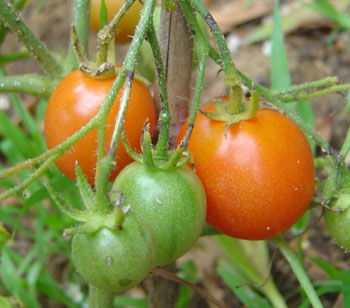The Organic Way to Protect Tomatoes from Caterpillars, Beetles, and Slugs
 Question from Kimberly:
Question from Kimberly:
I have some lovely tomatoes coming into harvest, however;they have little holes throughout the actual tomato and on the leaves! How to I prevent the bug that is eating my tomato? I don’t see it… I am not sure if it is a bug or catapillar? what do you suggest?
Answer from Pat:
My guess is that your tomatoes are beset with caterpillars. When you cut open a tomato you might find a caterpillar inside. Once they get inside there’s not much you can do. If a tomato is lying on the ground, soil pests such as sow bugs, slugs, and cut worms may attack it, but if the fruit is up inside the plant, most likely it is a tomato looper, a cabbage worm, or American bollworm caterpillar that attacked the fruit while it was still green. Sometimes fruit ripens anyway and you can simply cut off the bad bits, but often the fruit becomes inedible.
Another pest that attacks tomatoes is the tomato horn worm (an enormous green caterpillar 3 1/2 to 4 inches long, with a horn on the rear end), but these caterpillars usually eat leaves and stems only.
One of the best defenses against caterpillars is to encourage birds by providing feeders, bird houses, and a fountain with moving water. I had a wren nesting in my garden this year and watched it get so many caterpillars within a short amount of time that it must have caught in one day hundreds of the tiny ones. Blue birds are particularly effective. Purchase the correct type of house that protects the babies of bluebirds from attack by other birds, including jays, and do your research so you hang it at the right height and in the correct direction.
If there are scrub jays in your area, they are very effective against hornworms. (See page 200 in my book for a tip on how to attract them to your tomatoes. A local nurseryman told me lately that he has told many gardeners about this tip from my book and gardeners returned to let him know how well it worked for them. I have made a video on “Problem Solving in the Tomato Patch” , which includes this tip. Please watch this blog since it will be posted soon.)
Hand picking at night is also very effective, even against pests, including loopers and hornworms, and you might encounter beetles too. It’s best to start early in the season and stop pests in their tracks while they’re still young. Go out at night with a flashlight when the caterpillars, snails, slugs, and beetles are most active and visible. They hide in the daytime and come out at night and crawl about on top of plants. Best kinds of flashlights for this job fit with a band around your head so you can work with both hands. (You can buy one of these at a sporting goods store.) If you’re squeamish, wear surgical gloves. Bag the caterpillars securely and send them to the dump or squish the small ones. Ten o’clock at night is the best time to find them, but if you’re early to bed and early to rise, go out at dawn or just before dawn. That’s a good time too since pests will still be there, dew brings even more, and you can also see the damage they’ve done.
Some people spray with BT (Bacillus thuringiensis). (Always make sure you have a fresh bottle purchased this year. It doesn’t last forever. Mix it with a spreader-sticker for better cover.) Spinosad is often more effective than Bt, but can harm bees. Never purchase nor use Spinosad in the broad-cast-type of hose-end sprayer and do not use it where you see bees visit. To do so is a serious threat to bees and thus HUGELY damaging to the environment. (Please read my entries on bees on this blog.)
Personally I find the best way to control pests of all sorts, including caterpillars, is to grow an organic garden and thus attract many beneficials to help with pest control. You may even find tomato horn worms with white cocoons stuck to their backs. If so, leave them alone. These are the pupae of tiny braconid wasps. The larvae will consume the inside of the hornworm and then become mature wasps that will fly around your garden laying eggs on the backs of other caterpillars so their larvae will also parasitize and kill many more caterpillars. There are many beneficial wasps, including trichogramma wasps, which one can purchase and release in your garden. If you provide the right environment for them in your garden, they will settle down to stay and always be there to help you control pests. The main trick is not spraying and keeping a few water sources around and growing wildflowers and other flowers with many sources of pollen. This natural and built-in pest control is discussed in detail in my book in many chapters, including pages 157 forward to page 161, which concerns beneficials in particular.

